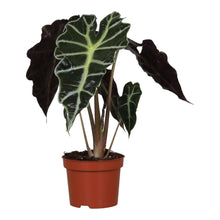Alocasia 'Polly', often also referred to as the African Mask Plant, is a popular and relatively compact Alocasia cultivar prized for its striking, arrow-shaped leaves and distinctive markings. This Alocasia features deep green leaves with prominent, light green or silvery veins, creating a beautiful contrast. The leaves often have a slightly wavy or scalloped edge, adding to their visual interest. It belongs to the Araceae family.
The name "Alocasia" comes from the Greek words "a" (without) and "kolokasia" (referring to the taro plant), highlighting a resemblance. "Polly" is a cultivar name, likely chosen for its appealing sound or perhaps a connection to the breeder who developed it.
Light: Alocasia 'Polly' thrives in bright, indirect light. Direct sunlight can scorch the leaves, while insufficient light may result in less vibrant colouring and slower growth. A spot near a window with filtered light, or a room with ample ambient light, is ideal.
Water: Alocasias prefer consistently moist, but not waterlogged, soil. Allow the top inch or two of soil to dry out slightly between waterings, but avoid letting the soil dry out completely. Water thoroughly when you do water, ensuring any excess water drains away. Overwatering can lead to root rot, while underwatering can cause the leaves to droop or brown.
Potting mix: A well-draining potting mix is essential. A blend of potting soil, perlite, and orchid bark or coco coir works well. Avoid mixes that retain too much moisture. A chunky mix, similar to what you might use for orchids or other epiphytic plants, can be beneficial.
Fertilising: Feed your Alocasia 'Polly' with a diluted, balanced liquid fertiliser every 4-6 weeks during the growing season (spring and summer). Reduce or stop fertilising during the autumn and winter months when growth slows.
Temperature: Alocasia 'Polly' prefers warm temperatures, ideally between 18-27°C (65-80°F). It is not frost-tolerant and should be protected from cold temperatures. Avoid placing it near draughts or heating/cooling vents.
Humidity: Alocasias benefit from higher humidity. Using a humidifier, or placing the plant on a pebble tray filled with water can be very helpful. Low humidity can lead to crispy leaf edges.
Dormancy: Alocasias can experience a period of dormancy, particularly during colder months or if stressed. During dormancy, they may lose some or all of their leaves. Reduce watering and avoid fertilising during this time. New growth should appear when conditions improve.
Toxicity: Like other Alocasias, 'Polly' is toxic if ingested, so keep it away from pets and small children. The sap can also be irritating to the skin.



